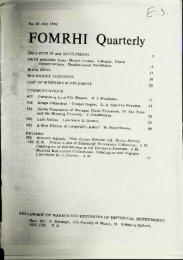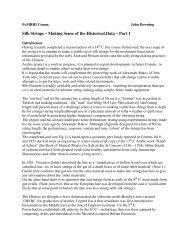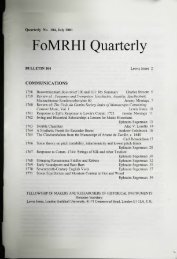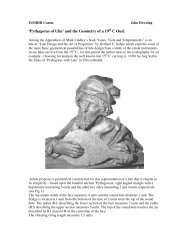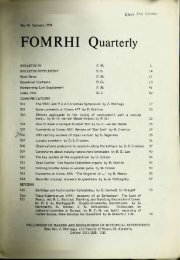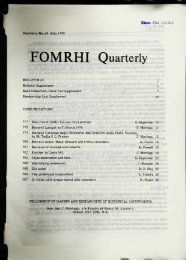• I f - FoMRHI
• I f - FoMRHI
• I f - FoMRHI
Create successful ePaper yourself
Turn your PDF publications into a flip-book with our unique Google optimized e-Paper software.
16<br />
cane is folded. This means that the tip of an<br />
18th-century reed wiU be closer to the one-ceU<br />
layer called the epidermis than in a modem<br />
level gouge. (The epidermis is sometimes mistakenly<br />
caUed the bark.) The next ceUular region<br />
just below the epidermis is the fiber band,<br />
where the ceUular material is most dense. This<br />
region is important to the structure of the plant<br />
because it gives the plant its rigidity so it can<br />
withstand the forces of wind and gravity. The<br />
fiber band is comprised of cells with thicker<br />
walls and increased amounts of Ugnin than<br />
cells in other regions. The increased amount of<br />
Ugnin in the fiber band is significant because it<br />
makes the fiber band water resistant and less<br />
flexible. These two properties of the fiber band<br />
are important to the playing characteristics of<br />
a historical bassoon reed and in particular to<br />
this discussion, because the water resistance<br />
and the lack of flexibiHty of the fiber band<br />
causes the tip area to perform in a certain manner.<br />
It must be pointed out that the different<br />
regions of ceUular material flow into each other;<br />
there is not a clear line between each of<br />
these layers. This is important because the cellular<br />
material becomes more rigid the closer it<br />
is to the fiber band because of the thicker ceU<br />
walls. When the tip of the reed is constructed<br />
from ceUular material in the fiber band, the tip<br />
absorbs less moisture than the other areas of<br />
the reed because of hgnin's water resistance.<br />
Therefore, the tip expands less when moist<br />
than the area behind the tip, which is constructed<br />
from the next ceUular region down<br />
known as the inner cortex. (The area behind<br />
the tip of the reed is comprised of inner cortex<br />
material because of the sloping of the reverse<br />
tapered gouge.) So as the reed dries, the inner<br />
cortex area of the reed behind the tip contracts<br />
more, forcing the tip to warp. In other words,<br />
the increased water resistance and the lack of<br />
flexibUity of the fiber band causes the tip of a<br />
historical reed to expand and contract at different<br />
degrees than the other areas of the reed<br />
which are made in the inner cortex. The different<br />
degrees of expansion and contraction in<br />
turn causes the tip opening to increase or the<br />
tip to warp when dry. This is why only a reed<br />
made with the tip in or close to the fiber band<br />
wUl warp when left to become bone dry. When<br />
contrasted to a modem bassoon reed, it is easy<br />
to see why the brief statement in HaUe is so<br />
important. The modem bassoon reed constructed<br />
with a thick level gouge, is made entirely<br />
from ceUular material of the inner cortex,<br />
so there are not different degrees of expansion<br />
and contraction in the ceUular regions of the<br />
cane. Therefore, it is not necessary to soak a<br />
modem reed as long as a true historical bassoon<br />
reed: warpage is usuaUy not a problem.<br />
After reading the primary sources on reed<br />
making for both the oboe and the bassoon<br />
from the late 18th and early 19th-centuries,<br />
and the more recent secondary sources on historical<br />
double reeds, I have come to the conclusion<br />
that reeds were made using a reverse<br />
tapered gouge. I, of course, am not the only<br />
bassoonist to have come to this conclusion -<br />
Paul White and others have caUed for the use<br />
of a more historical reed design years ago.<br />
However, many modem players of historical<br />
bassoons perform with reeds based on modem<br />
designs, made with more or less a level gouge.<br />
The modem design, where the tip is comprised<br />
of ceUular material of the inner cortex and not<br />
of the fiber band region of the cane, has many<br />
impUcations on the performance aspects of the<br />
bassoon such as tone quaUty, dynamics, ease of<br />
response, fingering, range, and flexibUity of<br />
pitch. A discussion of these performance aspects<br />
goes beyond the scope of this short<br />
communication, but I would like to say that in<br />
my experience, historical bassoons must be<br />
played using a sound generator with a design<br />
similar to the one for which the instrument was<br />
designed. Simply put, historical bassoons perform<br />
and sound differently depending on the<br />
design of the reed, and in particular, the type<br />
of gouge. Ozi knew exactly what he meant<br />
when he stated that the center of the cane<br />
should be gouged to a thickness of a quart de<br />
ligne d'epaisseur or about .55 mm.[5] Having<br />
spent three years constructing historical bassoon<br />
reeds with this gouge thickness at the<br />
center, I concur.<br />
I found this important source by being in<br />
the right place at the right time. Otherwise, I<br />
never would have thought to look in a discus-





